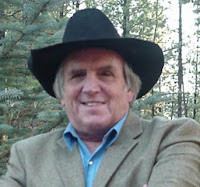 |
| Stephen Bly |
Stephen Bly
Copyright
©2008
Writers are gold miners at
heart. Any story worth its gems has the sweat of pickax research behind it.
In the historical novel, Cowboy
For A Rainy Afternoon, I discovered these jewels of info that played out in
the plot ...
1.) Personal experience
Set in 1955, with the
narrator as a 10-year-old boy, same as I would have been, I was able to draw on
some past knowledge.
 |
| Gary Cooper in High Noon |
In the story Tex Ritter
sang, "Do Not Forsake Me, Oh My Darlin'" on a juke box, and I had
known all the words since my youth when I saw High Noon multiple times at the
theater. But I didn't realize that Gary Cooper, who played Will Cane, was a
Montana boy, from Helena.
2.) History of a brand
Part of the story happens
in a Woolworth's store, which was a Five & Dime, sort of like a
"Dollar Store," only it included a soda fountain/lunch bar, better
merchandise, and a friendly clerk behind every counter.
The first Woolworth's store
was founded with a loan of $300 in 1878 by Frank Winfield Woolworth. Despite
growing to be one of the largest retail chains in the world through most of the
20th Century, increased competition led to its decline, beginning in the 1980s.
 |
| 1950s F.W. Woolworth store |
In 1997, F. W. Woolworth
Company converted into a sporting goods retailer, closing its remaining retail
stores that operated under the Woolworth's brand name. They renamed it Venator
Group. By 2001, the company focused on sporting goods and changed its name to
the present Foot Locker Inc.
A classic example of a
company that adapted to the market needs.
3.) Americana
The adventures in Cowboy For A Rainy Afternoon happen on U.S. Route 66. Known as "The Main Street of America" or
the "Mother Road," it was one of the original U.S. highways. Route 66
was established on November 11, 1926 and ran from Chicago, Illinois through
Missouri, Kansas, Oklahoma, Texas, New Mexico, Arizona and California where it
ended at Los Angeles. A total of 2,448 miles. The primary route for those
leaving the "dust bowl" and moving to California during the Great
Depression.
4.) Place names
"Coosie, did you ever'
cowboy up in the Dakotas?" Granddaddy asked.
"I drove some agency
beef to Pine Ridge a couple times. The second time I did it, I was cookin' for
the XIT," he admitted.
This conversation got me
curious about the XIT Ranch. In the 1880s it was the largest ranch in the world
under fence and it all laid in the Texas Panhandle. Three million acres
sprawled from the old Yellow House headquarters, near what is now Lubbock,
Texas, northward to the Oklahoma Panhandle, in an irregular strip roughly 30
miles wide.
It covered portions of ten
counties, which helped perpetuate the misbelief that the brand XIT stands for
"Ten In Texas." Actually, the brand served only as a means to thwart
rustlers.
Later, Coosie says, "I
didn't go much beyond Fort Rob, Nebrasky. Some locals came out and took the
herd from there. It wasn't too many years after that ruckus at Wounded Knee and
we was a little shy of rilin' up the Sioux."
Fort Robinson, in the
extreme northwest corner of Nebraska, was an important military installation
that played crucial roles in the Plains Indian Wars. It's a favorite site of
mine. I love to visit there.
5.) Quirky details.
Shorty cleared his throat.
"We must have got served some bad Mescal, because when me and Half-a-Bill
left a little after midnight we couldn't find our horses."
You got to love the old
cowboy names. Who today would tolerate being called Half-a-Bill?
I'm a tea-totaller myself.
Well, I drink that muddy, boiled coffee. But about the mescal Shorty mentioned ... it's a Mexican
alcoholic drink made from agave (maguey) plants.
There are many different
types of agave plants and each produces a different flavor of mezcal. The term mezcal
generally refers to all agave-based distilled liquors that are not tequila
(a mezcal variant allowed to be made only from the blue agave plant,
usually in the town of Tequila and the surrounding region of Jalisco).
The mezcal of Sonora is
called bacanora in reference to the municipality where it is made.
Chihuahuan mezcal is called sotol after the plant that is used there.
Now I know more about Mexican liquors than I ever needed to know.
~~~~~~~~~~~
What did you appreciate most about the research done in a novel you read recently?
~~~~~~~~~~~~~~
 | |
| Cowboy For A Rainy Afternoon |
This book and many others by Stephen Bly available on Amazon or the bookstore at http://BlyBooks.com



No comments:
Post a Comment